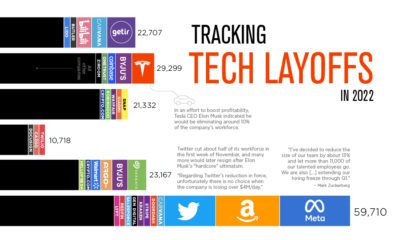These 8 Pivots by Startups Changed the World
How do successful companies get built? Is there a predetermined formula or ideal circumstances to get off on the right foot as an entrepreneur? When it comes to the technology world, the truth is that the most successful companies come in all shapes and sizes. Once in a while, strategy and its execution go as planned – but more often than not, a company must change its entire basis to get its best shot at winning. In the startup world, this is called a “pivot”. It’s a risky change of direction that could end up as a game-changing success or a resolute failure. Circumstances can change fast to prompt such a desperation move. With technological progress growing at an exponential rate, in many tech-focused businesses such pivots can even be the norm. There are many reasons a company may shake up its strategy. Maybe the customer response isn’t what was expected, or perhaps intuition suggests that a product could be used another way with a few modifications. Sometimes a mentor or friend may have a different vision on how something can be used, and other times a competitor can apply pressure to an early-stage startup by offering a similar or better product. I know something about pivots myself, as this website (Visual Capitalist) is the result of a few of them. We first started as a marketing consultancy, and then we gambled at the idea of using infographics to supplement the press releases of microcap public companies. Neither of those really were effective, but we still loved the idea of explaining the business and investment world with rich visuals – and eventually Visual Capitalist was born. Similarly, many other companies that we cherish would not exist without these types of strategic pivots. Twitter, Paypal, Nintendo, and many others were born under completely different circumstances than we know them today. Nintendo built vacuum cleaners and made instant rice until they thought the video game industry could be an interesting market. Nokia, which in the late 2000s was one of the biggest mobile phone makers by market share, used to have a Finnish paper mill and manufacture rubber goods in its early stages. Today’s infographic looks at eight of the startup pivots that have changed the world. Original graphic by: WhoisHostingThis?
on But fast forward to the end of last week, and SVB was shuttered by regulators after a panic-induced bank run. So, how exactly did this happen? We dig in below.
Road to a Bank Run
SVB and its customers generally thrived during the low interest rate era, but as rates rose, SVB found itself more exposed to risk than a typical bank. Even so, at the end of 2022, the bank’s balance sheet showed no cause for alarm.
As well, the bank was viewed positively in a number of places. Most Wall Street analyst ratings were overwhelmingly positive on the bank’s stock, and Forbes had just added the bank to its Financial All-Stars list. Outward signs of trouble emerged on Wednesday, March 8th, when SVB surprised investors with news that the bank needed to raise more than $2 billion to shore up its balance sheet. The reaction from prominent venture capitalists was not positive, with Coatue Management, Union Square Ventures, and Peter Thiel’s Founders Fund moving to limit exposure to the 40-year-old bank. The influence of these firms is believed to have added fuel to the fire, and a bank run ensued. Also influencing decision making was the fact that SVB had the highest percentage of uninsured domestic deposits of all big banks. These totaled nearly $152 billion, or about 97% of all deposits. By the end of the day, customers had tried to withdraw $42 billion in deposits.
What Triggered the SVB Collapse?
While the collapse of SVB took place over the course of 44 hours, its roots trace back to the early pandemic years. In 2021, U.S. venture capital-backed companies raised a record $330 billion—double the amount seen in 2020. At the time, interest rates were at rock-bottom levels to help buoy the economy. Matt Levine sums up the situation well: “When interest rates are low everywhere, a dollar in 20 years is about as good as a dollar today, so a startup whose business model is “we will lose money for a decade building artificial intelligence, and then rake in lots of money in the far future” sounds pretty good. When interest rates are higher, a dollar today is better than a dollar tomorrow, so investors want cash flows. When interest rates were low for a long time, and suddenly become high, all the money that was rushing to your customers is suddenly cut off.” Source: Pitchbook Why is this important? During this time, SVB received billions of dollars from these venture-backed clients. In one year alone, their deposits increased 100%. They took these funds and invested them in longer-term bonds. As a result, this created a dangerous trap as the company expected rates would remain low. During this time, SVB invested in bonds at the top of the market. As interest rates rose higher and bond prices declined, SVB started taking major losses on their long-term bond holdings.
Losses Fueling a Liquidity Crunch
When SVB reported its fourth quarter results in early 2023, Moody’s Investor Service, a credit rating agency took notice. In early March, it said that SVB was at high risk for a downgrade due to its significant unrealized losses. In response, SVB looked to sell $2 billion of its investments at a loss to help boost liquidity for its struggling balance sheet. Soon, more hedge funds and venture investors realized SVB could be on thin ice. Depositors withdrew funds in droves, spurring a liquidity squeeze and prompting California regulators and the FDIC to step in and shut down the bank.
What Happens Now?
While much of SVB’s activity was focused on the tech sector, the bank’s shocking collapse has rattled a financial sector that is already on edge.
The four biggest U.S. banks lost a combined $52 billion the day before the SVB collapse. On Friday, other banking stocks saw double-digit drops, including Signature Bank (-23%), First Republic (-15%), and Silvergate Capital (-11%).
Source: Morningstar Direct. *Represents March 9 data, trading halted on March 10.
When the dust settles, it’s hard to predict the ripple effects that will emerge from this dramatic event. For investors, the Secretary of the Treasury Janet Yellen announced confidence in the banking system remaining resilient, noting that regulators have the proper tools in response to the issue.
But others have seen trouble brewing as far back as 2020 (or earlier) when commercial banking assets were skyrocketing and banks were buying bonds when rates were low.














